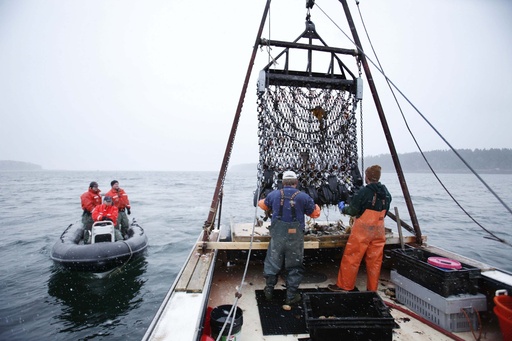
PORTLAND, Maine — Recent federal data has indicated a decline in both the volume and monetary value of the commercial fishing sector in the United States. Industry experts have pointed out that this downturn was anticipated after a significant increase in seafood supply in previous periods.
According to the National Oceanic and Atmospheric Administration (NOAA), the total amount of seafood caught at U.S. ports dropped by 2.6%, totaling 8.4 billion pounds in 2022. Additionally, the reported value of this catch saw a decline of 11%, amounting to $5.9 billion. These figures come from the NOAA’s latest “Fisheries of the United States” report released earlier this month, which provides comprehensive insights into the fishing industry.
Interestingly, per capita seafood consumption in the nation also slipped by around 3% to 19.8 pounds in the same year, as stated in the report. This comes after 2021 marked an unprecedented year for seafood consumption with a notable surge in available seafood. Gavin Gibbons, chief strategy officer for the National Fisheries Institute in Reston, Virginia, remarked that the decrease was a natural follow-up to an exceptional year.
Despite the decline, Gibbons is optimistic about some positive trends, specifically noting that the top ten seafood species consumed account for 79% of the total consumption. He highlighted that this marks a shift, as in previous years, those ten species represented nearly 90% of the consumption figures, indicating a diversification in consumer preferences.
The annual fisheries report serves as a comprehensive overview of the U.S. fishing industry’s size and scope. It revealed that both imports and exports of seafood increased, though the country’s seafood trade deficit swelled by 6% to surpass $24.2 billion. Canada, China, and Japan were recognized as the top export partners in the seafood trade.
The report further detailed that seafood landings experienced a decrease across all U.S. regions, with the exception of the Gulf of Mexico. Nevertheless, the catch volume and value remained above the levels recorded in 2020, a year when the fishing industry faced significant disruptions due to the COVID-19 pandemic, aligning more closely with figures from years prior to the pandemic.
Dutch Harbor in Alaska retained its status as the port with the highest catch volume for the 25th consecutive year. Meanwhile, New Bedford, Massachusetts, continues to lead the nation in catch value for the 22nd consecutive year. The report notes that sea scallops traditionally represent the majority of New Bedford’s landed value.
In terms of seafood value, the highest-ranking species in the country included salmon, lobster, crabs, Alaska pollock, and sea scallops. The report also identified shrimp, salmon, lobster, and crabs as the top imported products, with shrimp being the leading import in terms of value.
